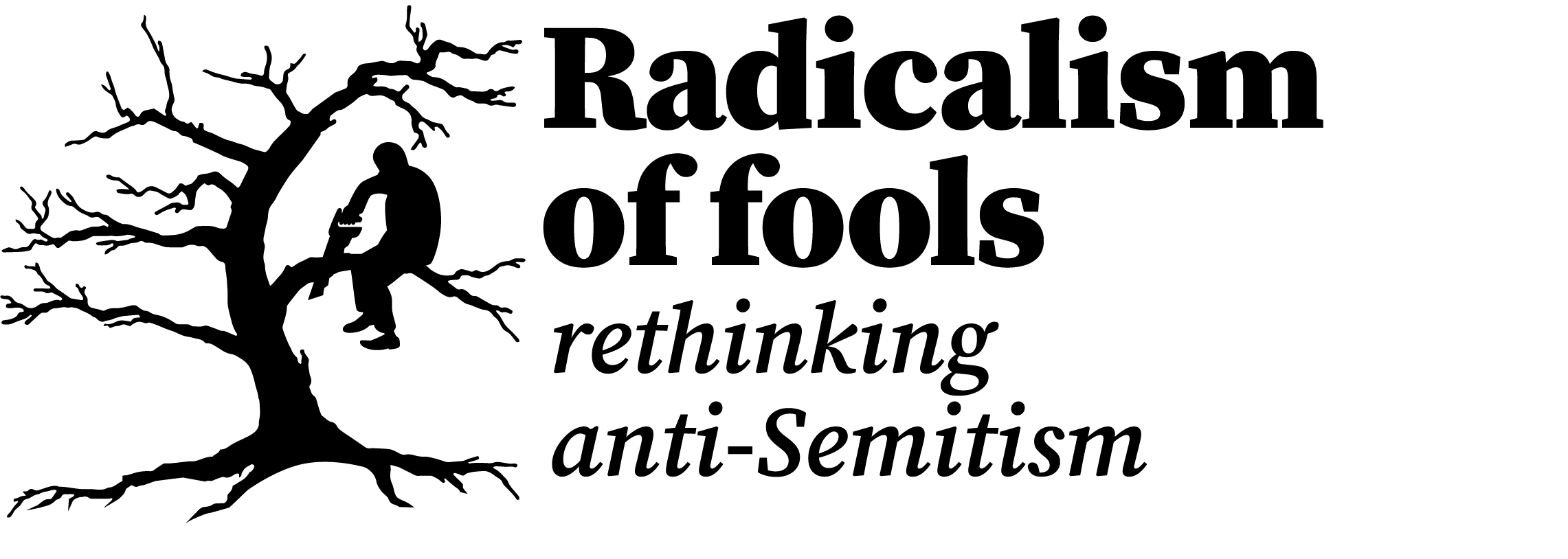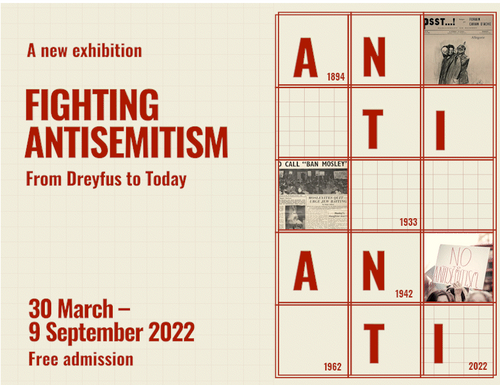The exhibition on “fighting antisemitism from Dreyfus to today” at London’s Wiener Holocaust Library unwittingly reflects many of the weaknesses of mainstream campaigns against contemporary anti-Semitism.
To be sure if the library had stuck to playing an educational role it would be providing a valuable service to the public. There is a nod to earlier instances of anti-Semitism but the main narrative starts in the late 1890s when Alfred Dreyfus, a French army officer of Jewish origin, was falsely accused of espionage. It then goes on to look at individuals, organisations and campaigns that have fought back against anti-Semitism in Britain, France and German since then. To get a flavour of some of the fascinating documents and photographs on display it is possible to watch a talk on the exhibition here.
On the outside windows of the library building are prominent posters advertising “new exhibition, fighting anti-Semitism”. On the day I visited a group of local school students were attending a series of talks. I inadvertently walked in on one where a Jewish woman who escaped Nazi Germany as a child was giving a talk based on her experiences. That was followed by a workshop on the discussion about whether or not there was a master plan to kill Europe’s Jews (this is sometimes referred to as the intentionalist-functionalist debate on the Holocaust).
The problem with the exhibition arises from its self-avowedly activist political purpose. This intent is stated explicitly in the short video promoting the exhibition (see video at the foot of this article) in which Toby Simpson, the director of the library, says: “One of the reasons we think doing an exhibition about fighting anti-Semitism is so important is that we want to support the fightback against anti-Semitism today”. At the end of the video he also says: “Come and learn what anti-Semitism is and how to challenge it.”
Once it crosses the line from educational exhibition to political campaign it has to be judged by the criteria it has set itself. In this case the key question is whether it lives up to its declared promise of helping to challenge contemporary anti-Semitism.
In my view it mystifies more than it clarifies. It makes the same mistakes and reflects the same evasions that are evident in so much of the discussion of tackling anti-Semitism today.
For a start, in the discussion of the period after the second world war there is too much emphasis on the far right. Just because a fascist movement was responsible for genocidal anti-Semitism in Nazi Germany before and during the war it does not follow that history will repeat itself. On the contrary, it is far more likely anti-Semitism will take different forms.
In Britain today the far right is mercifully marginal yet many opponents of anti-Semitism still present it as a substantial threat. Of course the extreme right should be dealt with when appropriate but portraying it as one of the gravest dangers today gets things completely out of proportion ( The situation in France and Germany is more complex but that is the subject for another article).
Too often those concerned with tackling anti-Semitism spend vast amounts of time chasing what are often tiny groups. No doubt far right fringe organisations are extremely nasty but thankfully they are generally minute. Of course there is always a chance that could change in the future but it does not seem to be the case today.
In contrast, movement which do pose a significant threat today are downplayed or ignored. Most notably, Islamism – the anti-modernist political movement that harnesses the language of Islam – poses a much bigger danger to Jews in Britain today than the far right. Yet there was no mention of it that I could see in this exhibition (full disclosure: because of the school student event I could not quite see the whole thing).
Typically the hostility to Jews embodied in Islamism manifests itself in relation to the discussion of Israel. It tends to present Israel not as a normal nation, with all the concomitant flaws that entails, but as the centre of an evil conspiracy to dominate the world. The Wiener exhibition does touch on the way apparent support for the Palestinians often embodies a coded form of anti-Semitism. But, as far as I could see, it shies away from openly examining how this relates to Islamism.
Perhaps the exhibition can be more easily forgiven for failing to explore identity politics given the outlook has only come to the fore relatively recently. Yet this too is becoming an important element of anti-Semitism today. Jews are often portrayed as beneficiaries of “white privilege”. From this warped perspective, anti-Semitism cannot by definition be seen as a form of racism since the overwhelming majority of Jews are white.
Another serious weakness is the failure to examine the broader social response to anti-Semitism – or perhaps more accurately the general lack of one. Discussing how Jewish organisations reacted to rising anti-Semitism is only part of the story of tackling it. The more difficult question is why radical forces in society more broadly have not generally attached much importance to tackling anti-Semitism. That was perhaps most clearly the case in Germany before the Nazi period where there were large avowedly socialist movements.
Of course a relatively small exhibition with limited resources can be forgiven for restricting its choice of topics given the archival material available. But once it sets itself up with the ambitious political aim of challenging contemporary anti-Semitism that will no longer do. Such one-sidedness only misleads rather than clarifying matters.
Finally, in the interests of balance, it is necessary to make one final point about the history of the Wiener Holocaust Library. The origins of the collection lie in the work of Dr Alfred Wiener who gathered evidence about anti-Semitism and the persecution of Jews in Germany in the 1920s and 1930s. In that sense it was always political rather than just a regular library.
No doubt it does excellent archival work but setting up an activist-oriented exhibition on tackling contemporary anti-Semitism takes it into another realm. In that respect it must be judged by political criteria rather than as a straightforward educational display.
Those who can get to London should by all means visit the exhibition. They will see plenty of fascinating material on display and can judge for themselves whether they agree with my take on its political shortcomings.
The exhibition runs until 9 September at the Wiener Holocaust Library, 29 Russell Square, London, WC1B 5DP. Admission is free.
Photo: Flyer for the "Fighting antisemitism from Dreyfus to today" exhibition at the Wiener Holocaust Library.

